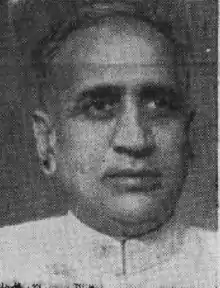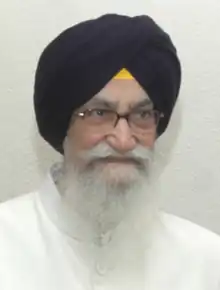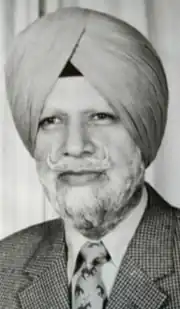List of chief ministers of Punjab, India
The chief minister of Punjab is the head of the government of Punjab. As per the Constitution of India, the Governor of Punjab is the state's head, but de facto executive authority rests with the chief minister. Following elections to the Punjab Legislative Assembly, the governor usually invites the party (or coalition) with a majority of seats to form the government. The governor appoints the chief minister, whose council of ministers are collectively responsible to the assembly. Given that he has the confidence of the assembly, the chief minister's term is for five years and is subject to no term limits.[1]
| Chief Minister of Punjab | |
|---|---|
 | |
| Government of Punjab | |
| Style | The Honourable (Formal) Mr. Chief Minister (Informal) |
| Status | Head of government |
| Abbreviation | CM |
| Member of | |
| Reports to | Governor of Punjab |
| Residence | House Number 7, Sector 2, Chandigarh, |
| Seat | Punjab Civil Secretariat, Capitol Complex, Chandigarh |
| Appointer | Governor of Punjab |
| Term length | At the confidence of the assembly Chief minister's term is for five years and is subject to no term limits.[1] |
| Precursor | Premier of the Punjab Chief Minister of PEPSU |
| Inaugural holder | Gopi Chand Bhargava |
| Formation | 5 April 1937 |
| Deputy | Deputy Chief Minister |
| Salary |
|
History
Punjab Province (1937-1947)
The province of Punjab was then headquartered in Lahore.Under the Government of India Act 1935, a bicameral legislature was set up with a legislative assembly and a legislative council with a government headed by the Prime Minister. The Unionist Party won the Punjab Provincial Assembly elections, 1937 and Sir Sikandar Hayat Khan became the Premier of Punjab and hold the position up to his death in 1942. Khan was succeeded by Sir Khizar Tiwana. In 1946 elections were held the Unionist Party stood fourth place but with the support of Indian National Congress and Shiromani Akali Dal formed the government under Sir Khizar Tiwana. Tiwana later resigned on 2 March 1947 against the decision of Partition of India.
Patiala and East Punjab States Union (1948-1956)
Patiala and East Punjab States Union or PEPSU was an Indian state formed by the union of the post-partition province of Punjab on the Indian side of the border with eight princely states, which were allowed to maintain their native monarchs. The state was inaugurated on 15 July 1948 and formally became a state in 1950. Among these princely states, six were salute states:- Patiala, Jind, Kapurthala, Nabha, Faridkot and Malerkotla. The other two states were Nalagarh and Kalsia. PEPSU was earlier headed by the Premier, from 1952 the chief minister become the head of the government. On 1 November 1956, PEPSU was merged mostly into East Punjab( Punjab from 1950) following the States Reorganisation Act, 1956.
East Punjab (1947-1966)
The state of East Punjab was formed in 1947 later it was renamed Punjab in 1950. It consisted of the parts of the Punjab Province of British India that went to India following the partition of India. Since 1947, Punjab has had fifteen chief ministers. The first was Gopi Chand Bhargava of the Indian National Congress party, who was sworn in on 15 August 1947, when India gained independence from the British. He was succeeded by fellow Congressman Bhim Sen Sachar, who was then subsequently replaced after 188 days by former Chief Minister Gopi Chand Bhargava. After a brief term, President Rajendra Prasad placed the Punjab Legislative Assembly under suspension for ninth months to help the state government gets its act together. In 1952, the first state elections took place for the Legislative Assembly. The results of the election saw the return of the Congress government with former Chief Minister Bhim Sen Sachar as its leader. After he resigned in 1956, Partap Singh Kairon became chief minister. Serving until 1964, Kairon remains one of Punjab's longest-serving chief ministers. He was followed by the returning Chief Minister Gopi Chand Bhargava, who briefly held office as acting chief minister for only 15 days. In July 1964, Ram Kishan assumed the office and served for two years. His tenure was followed by the President's rule which lasted for 119 days. On 1 November 1966, the state of Haryana was partitioned from Punjab and some other districts were given to the state of Himachal Pradesh.
Punjab (Since 1966)
The first chief minister of the newly re-configured state was Giani Gurmukh Singh Musafir who led a Congress government from the Vidhan Parishad, one of only two to have done so. In the 1967 elections, he was voted out of power in favour of the Akali Das Sant Fateh Singh Group whose leader Gurnam Singh became the first non-Congress chief minister. Gurnam Singh's government was succeeded by three short-lived Akali Dal governments—Lachhman Singh Gill's government for less than a year and a little more than a year under the returning Gurnam Singh and Parkash Singh Badal. After 272 days under President's rule, the Congress party returned to power under the future President Zail Singh. In 1977, Parkash Singh Badal became the chief minister for the second time. Darbara Singh became chief minister in 1980 and remained in office for three years before a long period under President's rule. A brief interlude under Surjit Singh Barnala followed, after which three Congress-led governments took office—led by Beant Singh from 1992 to 1995, Harcharan Singh Brar from 1995 to 1996 and Rajinder Kaur Bhattal from 1996 to 1997. Upon taking office, Rajinder Kaur Bhattal became the first female chief minister of Punjab and overall the 8th female chief minister in India.
Parkash Singh Badal assumed office for the third time in 1997 and became the first chief minister, since Kairon's resignation in 1964, to serve a full term. Badal was succeeded by Congressman Amarinder Singh, who also successfully served a full term. In 2017 he became CM for the second time but failed to complete his tenure due to internal political factionalism and Charanjit Singh Channi became the first Dalit chief minister of Punjab just 6 months before the expiry of the 15th assembly.
Office
The office of the chief minister of Punjab is located at Punjab Civil Secretariat, Sector – 1, Chandigarh.[3]
Key
|
|
- Acting Chief Minister
Precursors
Punjab Province (1937-1947)
| No | Portrait | Name
(Birth–Death) |
Party (Alliance/ Partner) |
Term of office[4] | Time in office | Assembly (Election) |
Appointed by | ||
|---|---|---|---|---|---|---|---|---|---|
| Took office | Left office | ||||||||
| 1 |  |
Sikandar Hayat Khan (1882-1942) (West-Punjab Landlord) |
Unionist Party (KNP) |
5 April 1937 | 26 December 1942[d] | 5 years, 265 days | 1st (1937) |
Herbert William Emerson | |
| 2 |  |
Malik Khizar Hayat Tiwana (1900-1975) (Khushab) |
30 December 1942 | 19 March 1945 | 2 years, 79 days | Bertrand Glancy | |||
| (i) | Governor Rule |
- | 19 March 1945 | 21 March 1946 | 1 year, 2 days | - | Viscount Wavell | ||
| (2) |  |
Malik Khizar Hayat Tiwana (1900-1975) (Khushab) |
Unionist Party (INC-SAD) |
21 March 1946 | 2 March 1947 | 346 days | 2nd (1946) |
Bertrand Glancy | |
| (ii) | Governor Rule |
- | 2 March 1947 | 15 August 1947[pd] | 166 days | - | Earl Mountbatten | ||
Patiala and East Punjab States Union (1948-1956)
| S.No. | Portrait | Name (birth-death) (Constituency) |
Party (Coalition) |
Tenure | Election (Assembly) | Appointed by | ||||
|---|---|---|---|---|---|---|---|---|---|---|
| Took Office | Left Office | Term in Office | ||||||||
| Premier of PEPSU (1948-1952) | ||||||||||
| - |  |
Gian Singh Rarewala (1901-1979) (Acting) |
Independent | 15 July 1948 | 13 January 1949 | 2 years, 312 days | Not Yet Created | Yadavindra Singh | ||
| 1 |  |
Gian Singh Rarewala (1901-1979) |
13 January 1949 | 23 May 1951 | ||||||
| 2 | N/A | Raghbir Singh (1895-1955) |
Indian National Congress | 23 May 1951 | 21 April 1952 | 334 days | ||||
| Chief Minister of PEPSU (1952-1956) | ||||||||||
| 1 |  |
Gian Singh Rarewala (1901-1979) (Amloh) |
Independent (SAD) |
22 April 1952 | 5 March 1953 | 317 days | 1952 (First) |
Yadavindra Singh | ||
| (i) |  |
Vacant[lower-alpha 1] (President's rule) |
- | 5 March 1953 | 8 March 1954 | 1 year, 3 days | - | |||
| 2 | N/A | Raghbir Singh (1895-1955) (Patiala Sadar) |
Indian National Congress | 23 May 1951 | 21 April 1952 | 334 days | 1954 (Second) |
Yadavindra Singh | ||
| 3 |  |
Brish Bhan (1908-1988) (Kalayat) |
12 January 1955 | 1 November 1956 [pd] |
1 year, 294 days | |||||
Chief Minister of Punjab
| S.No. | Portrait | Name (birth-death) (Constituency) |
Tenure | Party (Coalition) |
Election | Assembly | Appointed by | |||
|---|---|---|---|---|---|---|---|---|---|---|
| Took Office | Left Office | Term in Office | ||||||||
| Before reorganisation of Punjab (1947-1966) | ||||||||||
| 1 |  |
Gopi Chand Bhargava (1889-1966) (University) |
15 August 1947 | 13 April 1949[lower-alpha 2] | 1 year, 241 days | Indian National Congress | 1946 | Interim Assembly | C M Trivedi | |
| 2 |  |
Bhim Sen Sachar (1894-1978) (Lahore City) |
13 April 1949 | 18 October 1949 | 188 days | |||||
| (1) |  |
Gopi Chand Bhargava (1889-1966) (University) |
18 October 1949 | 20 June 1951 | 1 year, 245 days | |||||
| (i) |  |
Vacant[lower-alpha 1] (President's rule) |
20 June 1951 | 17 April 1952 | 302 days | - | ||||
| (2) |  |
Bhim Sen Sachar (1894-1978) (Ludhiana City South) |
17 April 1952 | 22 July 1953 [lower-alpha 3] | 3 years, 281 days | Indian National Congress | 1952 | First | C M Trivedi | |
| 22 July 1953 | 23 January 1956 | C P N Singh | ||||||||
| 3 |  |
Partap Singh Kairon (1901-1965) (Sujanpur) |
23 January 1956 | 9 April 1957 | 8 years, 150 days | |||||
| 9 April 1957 | 11 March 1962 | 1957 | Second | |||||||
| 12 March 1962 | 21 June 1964 | 1962 | Third | N V Gadgil | ||||||
| - |  |
Gopi Chand Bhargava (1889-1966) (MLC) (Acting) |
21 June 1964[lower-alpha 4] | 6 July 1964 | 15 days | P T A Pillai | ||||
| 4 |  |
Ram Kishan (1913-1971) (Jalandhar North East) |
7 July 1964 | 5 July 1966 | 1 year, 363 days | |||||
| (ii) |  |
Vacant[lower-alpha 1] (President's rule) |
5 July 1966 | 1 November 1966 | 119 days | - | ||||
| After reorganisation of Punjab (Since 1966) | ||||||||||
| 5 |  |
Giani Gurmukh Singh Musafir (1899-1976) (MLC) |
1 November 1966 | 8 March 1967 | 127 days | Indian National Congress | 1962 | Third | Dharma Vira | |
| 6 | .jpg.webp) |
Gurnam Singh (1899-1973) (Qila Raipur) |
8 March 1967 | 25 November 1967 | 262 days | Akali Dal Sant Fateh Group (PUF) |
1967 | Fourth | ||
| 7 |  |
Lachhman Singh Gill (1917-1969) (Dharamkot) |
25 November 1967 | 23 August 1968 | 272 days | Punjab Janata Party (INC) |
D C Pavate | |||
| (iii) |  |
Vacant[lower-alpha 1] (President's rule) |
23 August 1968 | 17 February 1969 | 178 days | - | ||||
| (6) | .jpg.webp) |
Gurnam Singh (1899-1973) (Qila Raipur) |
17 February 1969 | 27 March 1970 | 1 year, 38 days | Shiromani Akali Dal (UFP till 1970) (BJS 1970-71) |
1969 | Fifth | D C Pavate | |
| 8 |  |
Parkash Singh Badal (1927-2023) (Gidderbaha) |
27 March 1970 | 14 June 1971 | 1 year, 79 days | |||||
| (iv) |  |
Vacant[lower-alpha 1] (President's rule) |
14 June 1971 | 17 March 1972 | 277 days | - | ||||
| 9 | .png.webp) |
Zail Singh (1916-1994) (Anandpur Sahib) |
17 March 1972 | 30 April 1977 | 5 years, 44 days | Indian National Congress (Indira) (CPI) |
1972 | Sixth | M M Chaudhary | |
| (v) |  |
Vacant[lower-alpha 1] (President's rule) |
30 April 1977 | 20 June 1977 | 51 days | - | ||||
| (8) |  |
Parkash Singh Badal (1927-2023) (Gidderbaha) |
20 June 1977 | 17 February 1980 | 2 years, 242 days | Shiromani Akali Dal (JP & CPI) |
1977 | Seventh | M M Chaudhary | |
| (vi) |  |
Vacant[lower-alpha 1] (President's rule) |
17 February 1980 | 6 June 1980 | 110 days | - | ||||
| 10 |  |
Darbara Singh (1916-1990) (Nakodar) |
6 June 1980 | 6 October 1983 | 3 years, 122 days | Indian National Congress (Indira) | 1980 | Eighth | J L Hathi | |
| (vii) |  |
Vacant[lower-alpha 1] (President's rule) |
6 October 1983 | 29 September 1985 | 1 year, 358 days | - | ||||
| 11 |  |
Surjit Singh Barnala (1925-2017) (Barnala) |
29 September 1985 | 11 June 1987 | 1 year, 255 days | Shiromani Akali Dal | 1985 | Ninth | Arjun Singh | |
| (viii) |  |
Vacant[lower-alpha 1] (President's rule) |
11 June 1987 | 25 February 1992 | 4 years, 259 days | - | ||||
| 12 | .png.webp) |
Beant Singh (1922-1995) (Jalandhar Cantonment) |
25 February 1992 | 31 August 1995 [†] |
3 years, 187 days | Indian National Congress (Indira) | 1992 | Tenth | Surendra Nath | |
| 13 |  |
Harcharan Singh Brar (1922-2009) (Muktsar) |
31 August 1995 | 21 November 1996 | 1 year, 82 days | B K N Chhibber | ||||
| 14 |  |
Rajinder Kaur Bhattal (b. 1945) (Lehra) |
21 November 1996 | 11 February 1997 | 82 days | |||||
| (8) |  |
Parkash Singh Badal (1927-2023) (Lambi) |
12 February 1997 | 26 February 2002 | 5 years, 14 days | Shiromani Akali Dal (BJP) |
1997 | Eleventh | ||
| 15 |  |
Amarinder Singh (b. 1942) (Patiala Urban) |
26 February 2002 | 1 March 2007 | 5 years, 3 days | Indian National Congress | 2002 | Twelfth | J F R Jacob | |
| (8) |  |
Parkash Singh Badal (1927-2023) (Lambi) |
1 March 2007 | 14 March 2012 | 10 years, 15 days | Shiromani Akali Dal (BJP) |
2007 | Thirteen | S F Rodrigues | |
| 14 March 2012 | 16 March 2017 | 2012 | Fourteenth | Shivraj Patil | ||||||
| (15) |  |
Amarinder Singh (b. 1942) (Patiala Urban) |
16 March 2017 | 20 September 2021 | 4 years, 188 days | Indian National Congress | 2017 | Fifteenth | V P S Badnore | |
| 16 |  |
Charanjit Singh Channi (b. 1963) (Chamkaur Sahib) |
20 September 2021 | 16 March 2022 | 177 days | Banwarilal Purohit | ||||
| 17 | Bhagwant Mann (b. 1973) (Dhuri) |
16 March 2022 | Incumbent | 1 year, 225 days | Aam Aadmi Party | 2022 | Sixteenth | |||
Notes
- President's rule may be imposed when the "government in a state is not able to function as per the Constitution", which often happens because no party or coalition has a majority in the assembly. When President's rule is in force in a state, its council of ministers stands dissolved. The office of the chief minister thus lies vacant, and the administration is taken over by the governor, who functions on behalf of the central government. At times, the legislative assembly also stands dissolved.[5]
- Bhargava resigned from the post of chief minister on 6 April 1949 but hold the office until Sachar succeeded him on 13 April.
- Sachar resigned from the post of Chief Minister due to the differences with cabinet ministers Sri Ram Sharma, but on same day re-sworn as Chief Minister.
- Bhargava was also the only caretaker Chief Minister who served for a few days due to the resignation of Partap Singh Kairon.
References
- Durga Das Basu. Introduction to the Constitution of India. 1960. 20th Edition, 2011 Reprint. pp. 241, 245. LexisNexis Butterworths Wadhwa Nagpur. ISBN 978-81-8038-559-9. Note: although the text talks about Indian state governments in general, it applies for the specific case of Punjab as well.
- Bhagwant Mann. Pay Check. Retrieved 13 October 2022.
- "Chief Minister, Punjab Office". Retrieved 31 March 2022.
- World statesman - British India
- Amberish K. Diwanji. "A dummy's guide to President's rule". Rediff.com. 15 March 2005.